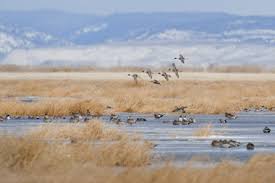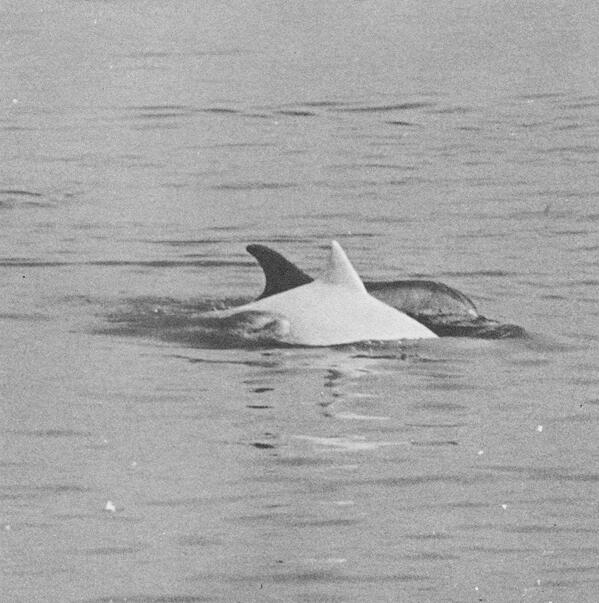 |
Flathead Lake by majikphil3.blogspot.com
 |
| Flathead Lake in Winter by brix.berg.com |
|
|
| | |
|
|
Assured that there were gulls at Flathead Lake all year long, I left Holland Lake for the 50-plus mile drive north, where I expected to off-load my cargo, then return to Holland Lake Lodge with their pet carrier. The four mile drive over the washboard road from the Lodge to the highway was the longest of the entire trip. Poor, trusting Sully had been slapped into a cage, covered with a blanket, and was now being rattled about like a bean in a can. He flapped and paced for the entire drive. On the upside, I figured he'd never put his survival in the hands of another human being.
 |
| Malheur NWR Oregonlive.com |
An hour after leaving the Lodge, I arrived at the north end of Flathead Lake. I drove from point to point along the lake, scanning it with binoculars for gulls. There were none. I turned around and headed south on Hwy. 35, which paralleled the east side of the lake, pulling over at every opportunity to scope out the shoreline. I began to feel like an idiot for not trusting my instincts. Of course, there were no gulls. What would they eat over winter even if the lake didn't freeze, which I was told it never did. At the southern tip of the lake, I turned south toward Missoula. The next best option was Malheur National Wildlife Refuge, in southeast Oregon--a day and a half away.
About this time the Maintenance Required light that had been flashing each time I started the Prius, came on permanently.
I was south of Missoula on some back road, when I found a nice pull off and decided to see if feeding Sully would relive his unrelenting anxiety. The writers group had pitched in fish from our last meal at the Lodge. I had a Ziploc full of halibut, a couple of scallops, a lovely chunk of Panko-crusted trout, and some scrambled eggs.
You may recall from Part I that I'd planned to camp both coming and going to Montana, so the entire length of the rear of the passenger side of the car was filled with a feather comforter folded in half. Behind my seat was a folding chair on top of which I'd placed Sully's pet carrier. A small cooler was behind the passenger seat with the head of the comforter covering it. My laptop and all associated paraphernalia were in a backpack, on top of the comforter, as was my suitcase. There was another bag containing a cook-stove, plate, cutting board, and utensils jammed in next to the cooler. Oh, and a bag of groceries, whittled down to crackers, a can of Wasabi peas, peanut butter, toilet paper and paper towels.
I failed to mention that I'd lined the bottom of Sully's cage with a couple sheets of newspaper for the drive to Flathead Lake. Not nearly enough, but like most smells you get used to them, and frankly, I kind of grew to like it. Anyway, I got some fish and eggs from the Ziploc in the cooler, then traipsed around to Sully's side of the car, open the cage door wide enough to get my arm in, and fed him. After that, he settled down.
I'd been up since before dawn and, with Sully quiet, I started to get sleepy myself. I was on Hwy. 93, which paralleled the lovely Salmon River. I found a wayside park, pulled in, climbed onto that down bed, put my legs on top of my suitcase, and fell asleep until Sully fluffed his feathers about 10 minutes later.
We're by then about 350 miles into the trip and the first night on the road to Malheur was looming. There were campgrounds along the river, but what were the chances I'd get a wink of sleep? I looked at the map and decided the next town I came to large enough to have a motel would be it for the day. What exactly I was going to do with Sully, I wasn't sure, but as we became fond of saying at the writers workshop. "I'll burn that bridge when I come to it." (This story is long enough without explaining how funny we thought that was.)
 |
| I owe them 4 stars. Northgate Inn, Challis. |
The Northgate Inn, Challis, ID. Their sign said, WiFi and pets welcome. It was family owned and the nice lady asked me, when I checked in, if I had a pet. I was honest. I said a bird.
"I won't charge you for it."
I'm pretty sure her mind went to a parakeet, or maybe a canary, but she didn't ask and I didn't tell her. Though my room was near the front, I parked at the rear entrance to the motel, checked that the coast was clear, and rushed down the hall with Sully's cage.
When I checked in, I specifically asked if the rooms had bathtubs. I'm sure you can see my thinking here. They did and that's where Sully spent the night. I ran a little water in tub, and opened the cage door. He wasn't too eager to come out until I splashed water like a bird bathing. He couldn't resist then. I put the cage on the floor, and started filling the tub. It scared him at first, but with the shower curtain pulled, he couldn't get out. I filled it more slowly, and pretty soon, he was all in. He bathed with wing-slapping joy, not once but three times. I fed him, made sure the shower curtain had no gaps, and turned out the light. Night, night, bird.
I won't go into what the tub looked like in the morning. I drained it, fed Sully, refilled it so he could bathe again, then put him in his cage, and took a shower myself to rinse away any further evidence.
 |
| Sunrise in Challis, ID |
I carry a Fort Bragg phone book in my car. I looked up my mechanic's home phone number and called to ask if I should worry about the Maintenance Required light. He said it meant I needed an oil change, and not to worry.
"I'm about 1000 miles from home."
"You'll make it."
My second call was to Ron LeValley, an authority on birds. He said Malheur would be a perfect place for Sully, and if not there, try Klamath NWR in south central Oregon.
There was a little restaurant a block or two down the street. For breakfast, I ordered one egg over easy and one egg scrambled to go.
 |
| Hwy 93 out of Challis Flickr.com |
In memory of Oscar "Bud" Owre
on this his birthday




































































